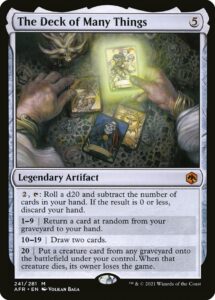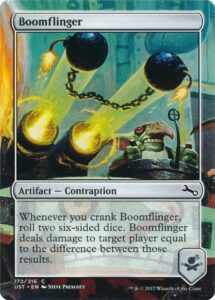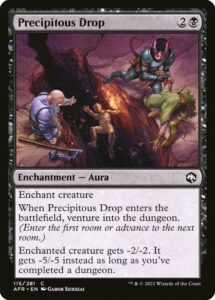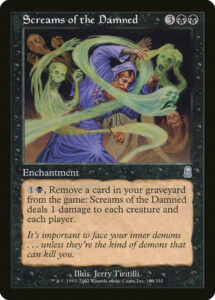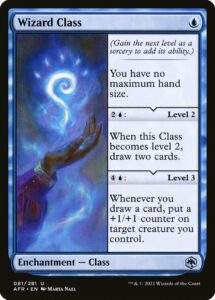As 2021 draws to a close, there’s a year’s worth of new mechanics to reflect upon. We started by reviewing all five new mechanics from Midnight Hunt. This week, we’ll move a bit farther back in times with Adventures in the Forgotten Realms.
AFR introduced three new mechanics: Venture, rolling d20 (six-sided dice had previously been used in Un-sets), and Class enchantments. Those three will be our primary focus today, though we should acknowledge that AFR also introduced flavor words and the new ability word, Pack Tactics.
Flavor words are a good way to encapsulate and communicate a mechanical story, helping onramp D&D players into Magic and vice versa. They do however create some confusion when used alongside ability words, since flavor words are unique to each card while ability words communicate similarities across cards.
This issue was noted in Mark Rosewater’s State of Design and could have been addressed if flavor words weren’t templated the same way that ability words are. It could have also been avoided by not including any ability words, but at least now Magic has learned the lesson that mixing the two with identical templating isn’t ideal. With that said, let’s move on to our three new mechanics.
Rolling d20
Wizards had a very fine line to walk when crafting this mechanic.
On the one hand, twenty-sided dice are absolutely central to Dungeons & Dragons. Anyone who’s played will remember the highs of a natural 20 at just the right time and the hilarious or heartbreaking lows of a natural 1 at just the wrong time.
On the other hand, overt randomness in strategy games can elicit intense dislike. Magic has traditional shied away from such explicit randomness, using die rolling and coin flipping sparingly and at lower power levels—we don’t see cards like Mana Crypt anymore that are ludicrously powerful auto-includes but lead to games hinging on literal coinflips.
That isn’t to say that Magic doesn’t have high variance—it’s a game defined by drawing cards from a large, shuffled deck. But Magic’s variance is more obscured, it feels different drawing from the shufflebag of a deck (where every card drawn changes the odds what you can draw) rather than rolling a die (where one roll has no bearing on the next).
Wizards had a major challenge in adding an overtly random mechanic into a game already full with obscured randomness. Make the cards too powerful and Constructed players, especially competitive Constructed players, get angry when games feel entirely out of their control. Make the cards too weak and not enough people want to play with them. Wizards opted to minimize the variance of their d20 cards. With the exception of the rare Deck of Many Things and Treasure Chest which produce wildly different outcomes, every card follows the pattern set by Contact Other Plane: a low result with a beneficial effect, a medium result that’s an improved version of that low result, and if there’s room, a 20 result that’s a substantially above rate version of the low result.
The benefit of this approach is it creates a very palatable form of randomness, especially to Spikes. The floor of the effect isn’t too far from the ceiling. Every now and then, you hit the 5%er and turn Contact Other Plane into Precognitive Perception, but for the other 95% of the time, Behold the Multiverse is better and therefore gets played in Standard. This design schema also eliminates any penalties from a natural 1, meaning players are never afraid to play their cards. That’s good game design, especially in a set that’s essentially a Core Set intended to introduce D&D players to Magic. Finally, by having similar outcomes across all die rolls, it’s easy to remember what a card does and predict what it’s capable of. If everything was disparate, analysis paralysis could overwhelm players.
The problem with this approach is it cuts out most of the drama of the rolls. With power level and variety of outcome compressed to minimize variance, the variance isn’t nearly as thrilling. You don’t risk the pain of a nat 1, just the very likely 45% chance of the low result. It does still give you the joy of a nat 20, but it’s not as thrilling when that just means creating one extra treasure token. In addition, the level of restraint made the mechanic meaningful in Limited, but nearly impossible to build around. The UR die rolling deck was nearly nonfunctional given how low in power and quantity the die rolling cards were.
Overall, I think Wizards chose the safest and best course of action with die rolling in AFR. I was skeptical of the mechanic when I first saw it and ended up disappointed that I couldn’t roll enough dice. Yes, the restraint hindered the mechanic’s impact, but given how divided Magic’s player base is on randomness, I think any other course would’ve lead to bigger issues. It would’ve been a mess if every card had read like Treasure Chest and a mistake if no card did. Looking ahead it’ll be interesting seeing how Magic learns from AFR and employs die-rolling in the future, especially with it embracing more high variance cards on Arena.
Venture
Magic had never before done a mechanic quite like Venture. It was so new and exciting that we took a stab at evaluating it before AFR ever came out. And since we’ve said so much about it already, we’ll skip describing the mechanic and go right on to evaluation.
Rolling d20 needed a lot of restraint because Magic was employing a mechanic known to be controversial among its player base. Venture wanted some restraint because of how much of an unknown it was. Ultimately, Venture had far, far too much restraint.
The first lesson I learned upon playing with Venture is that the mechanic is far weaker than it looks. Getting ~1 to 1.5 mana of value per room on average made sense on paper, but fell short in practice. The rewards being distributed over random bursts of time diminishes their impact. It’s not like Sagas or Suspend, where you know exactly when you’ll get your rewards. Sometimes, you complete two rooms in a turn and it feels good, other times, you never reach the Temple of Dumathoin (“Draw a card” in the Lost Mine of Phandelver) and your effort is mostly wasted. Moreover, each room having wildly disparate rewards further diminishes their impact. Making a Goblin or getting a Treasure can be really helpful at the right time, but you have very limited control over when you get them. And even if they are helpful, there’s no guarantee you’ll be able to take advantage of what’s in the next rooms.
It’s not a problem for a mechanic to not be powerful. Patrick Sullivan made an excellent case in the Resleevables Dark Ascension episode that Fateful Hour must be both underpowered and used sparingly in order to function. I’d argue it is an issue for both Venture and rolling d20, AFR’s two marquee mechanics, to both be underpowered; but I can also understand Wizards easing off the power level after Throne of Eldraine, Theros Beyond Death, Ikoria: Lair of Behemoths, and Kaldheim. It’s unfortunate, but understandable. That’s hardly damning.
The damning thing is that only a third of Venture matters. When I first saw the mechanic, I’d pegged the Lost Mine of Phandelver as the obvious, easy, always good option. It’s the simplest to remember, has a quick path to completion, and its rooms are all beneficial and impactful. Newer players could go there, while experienced players could leverage their skill by knowing when to opt for the Dungeon of the Mad Mage or Tomb of Annihilation.
It turns out, the correct answer as to when you should go to the other two dungeons is almost never. Venture being weaker than it looked meant that getting an immediate benefit (which the Lost Mine of Phandelver provides) is so, so much more valuable than a delayed payoff (which the other two offer). The mechanic contracted from three choices, each with their own little flow chart, into one simple flow chart. The biggest choice it provides is actually a false one. That’s a shame.
I can’t fault Wizards’ approach too much—Venture was a completely unknown mechanic. It presents a hefty upfront choice. If a player wants to optimize their decision, they need to read (and possibly memorize) three tokens that are dense with text. Players have a tendency to overoptimize and have less fun, so it behooves game designers to make such decisions relatively quick and painless. Unfortunately, Wizards succeeded too well at making an optimization problem easy and undermined two thirds of their work, leading to the vast majority of rooms being ignored by inexperienced and experienced players alike.
Venture feels underbaked, as though it absolutely had to be included even though it suffered from critical flaws. It would have been monotonous to have just a single dungeon, but as soon as you add more dungeons, you create memory and optimization issues. The solution has to be to make an easy, right choice, but that makes it all the more likely the mechanic coalesces around the best dungeon (and so becomes monotonous).
I wouldn’t be surprised if Wizards adds another dungeon or two in Commander Legends: Battle for Baldur’s Gate, and in so doing, add more Venture options into Standard (at least, I think that’s how it works—if Wizards adds new dungeons into a non-Standard set, Standard sets can still Venture into them). It gives them an opportunity to rectify some of the issues with Venture, but ultimately, I see Venture as one of the most disappointing major mechanics ever. It’s not a workhorse mechanic like Cohort or Sweep that’s sort of just there in a set, it’s a mechanic that had a lot riding on it, like Megamorph, and it really didn’t deliver.
Class Enchantments
After ragging on Venture, let’s end on a high note. I adore class enchantments. They reimagine and improve on Level Up cards from Rise of the Eldrazi (such as Lighthouse Chronologist or Student of Warfare). Since they’re not creatures, there’s no confusion about what stats it has when. Wizards clearly learned from this confusion by having each level add its effects to the previous level’s rather than replace them.
In addition to being mechanically clearer, the class enchantments are visually clearer. They don’t need to communicate a major change in physical state. They can be simple and abstract. And if a player has ever seen a saga, they’ve seen a very similar layout and have some built-in intuition about the additive nature of effects. Moreover, there’s a subtle bit of brilliance—these reverse the art and text, making them clearly distinct from sagas.
Finally, the narrative here is outstanding! If you’ve ever played D&D, you’ve selected a class for yourself. This is an entire class of enchantments that let you become something, just like Form of the Dragon! I love everything about Class cards. They’re aspirational, they tell great stories, they’re mana sinks, they’re absolutely on theme for Dungeons & Dragons, and they make me excited for future designs in this vein.
And that’s all I’ve got to say about the mechanics of Adventures in the Forgotten Realms. Venture and rolling d20 both required restraint (for different reasons) and Venture fell painfully short in my opinion. On the other hand, Class cards are awesome and I can’t wait to see more of them and inspired by them. We’re certain to see some lessons from AFR applied in a few months when Battle for Baldur’s Gate releases, and I’m excited to see them in action.
Zachary Barash is a New York City-based game designer and the commissioner of Team Draft League. He designs for Kingdom Death: Monster, has a Game Design MFA from the NYU Game Center, and does freelance game design. When the stars align, he streams Magic (but the stars align way less often than he’d like).


